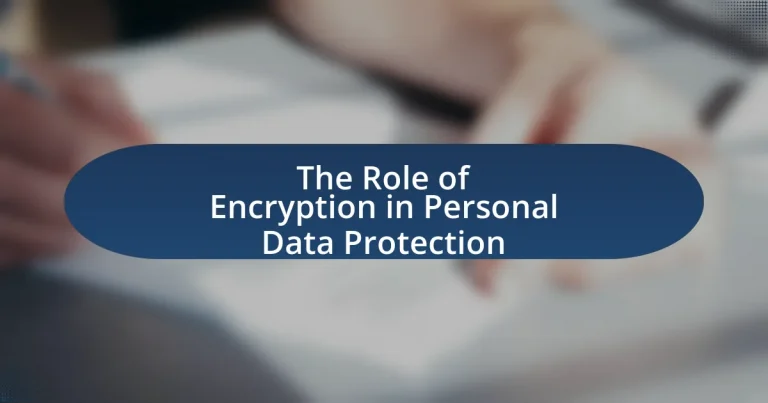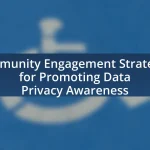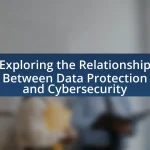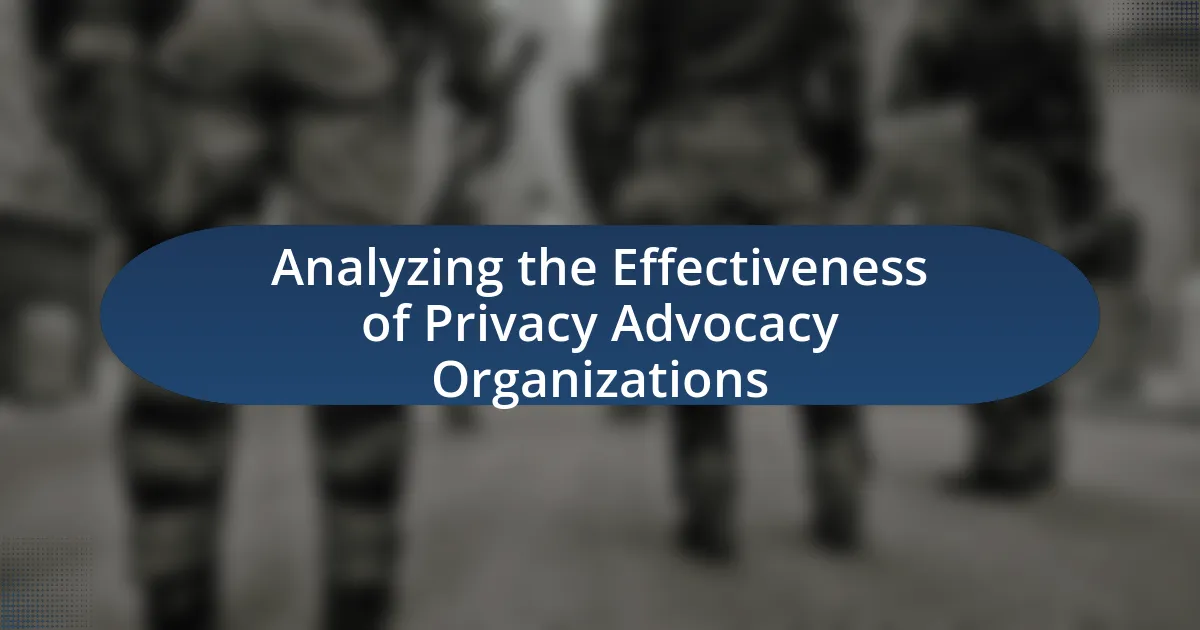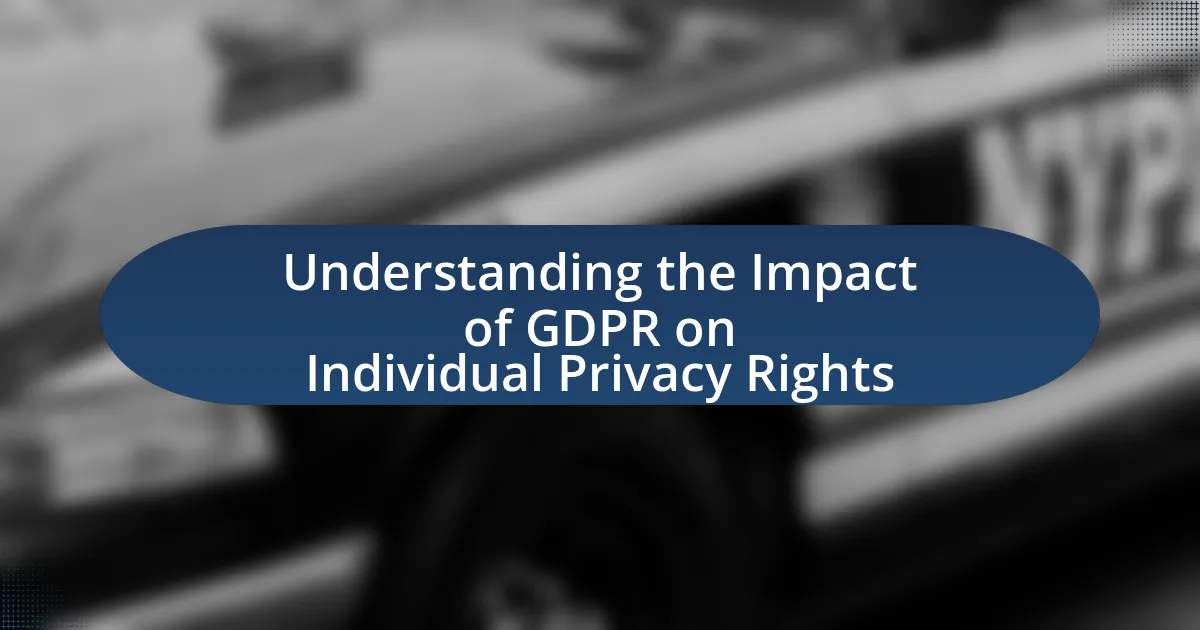Encryption is a vital mechanism for personal data protection, transforming sensitive information into a coded format that is unreadable without the correct decryption key. This article explores the significance of encryption in safeguarding personal data, detailing how it prevents unauthorized access, complies with data protection regulations, and mitigates risks associated with data breaches. It examines various encryption methods, including symmetric and asymmetric encryption, and discusses the challenges and misconceptions surrounding encryption practices. Additionally, the article highlights best practices for individuals to enhance their encryption efforts, ensuring robust protection of personal information against cyber threats.

What is the Role of Encryption in Personal Data Protection?
Encryption plays a critical role in personal data protection by converting sensitive information into a coded format that is unreadable without the appropriate decryption key. This process ensures that even if data is intercepted or accessed by unauthorized individuals, it remains secure and confidential. For instance, according to the 2020 Verizon Data Breach Investigations Report, 80% of data breaches involved unencrypted data, highlighting the importance of encryption in safeguarding personal information. By implementing encryption, organizations can comply with data protection regulations such as the General Data Protection Regulation (GDPR), which mandates the protection of personal data through appropriate security measures.
How does encryption safeguard personal data?
Encryption safeguards personal data by converting it into a coded format that is unreadable without the appropriate decryption key. This process ensures that even if unauthorized individuals access the data, they cannot interpret it, thereby protecting sensitive information such as financial records, personal identification, and health information. For instance, the Advanced Encryption Standard (AES) is widely used and recognized for its effectiveness in securing data, as it employs complex algorithms that make it extremely difficult to crack. According to a report by the National Institute of Standards and Technology (NIST), encryption significantly reduces the risk of data breaches, as encrypted data remains secure even if intercepted during transmission or storage.
What types of encryption are commonly used for personal data protection?
Commonly used types of encryption for personal data protection include symmetric encryption, asymmetric encryption, and hashing. Symmetric encryption, such as AES (Advanced Encryption Standard), uses the same key for both encryption and decryption, making it efficient for large data sets. Asymmetric encryption, exemplified by RSA (Rivest-Shamir-Adleman), employs a pair of keys—public and private—allowing secure data exchange without sharing the private key. Hashing algorithms, like SHA-256 (Secure Hash Algorithm), convert data into a fixed-size string of characters, ensuring data integrity by producing a unique hash for each input. These encryption methods are widely adopted due to their effectiveness in safeguarding personal information against unauthorized access and breaches.
How does encryption prevent unauthorized access to personal data?
Encryption prevents unauthorized access to personal data by transforming readable information into an unreadable format using algorithms and keys. This process ensures that only individuals with the correct decryption key can access the original data, thereby safeguarding it from unauthorized users. For instance, the Advanced Encryption Standard (AES) is widely used and recognized for its effectiveness in securing sensitive information, as it employs complex mathematical transformations that make it nearly impossible for attackers to decipher without the appropriate key. Consequently, encryption acts as a critical barrier against data breaches and unauthorized access, protecting personal information from malicious entities.
Why is encryption essential for data privacy?
Encryption is essential for data privacy because it transforms sensitive information into an unreadable format, ensuring that only authorized parties can access it. This process protects personal data from unauthorized access, breaches, and cyberattacks, which have been on the rise; for instance, the Identity Theft Resource Center reported over 1,100 data breaches in the U.S. in 2020 alone. By using encryption, organizations can comply with regulations such as GDPR and HIPAA, which mandate the protection of personal data, thereby reinforcing the importance of encryption in safeguarding individual privacy.
What are the risks of not using encryption for personal data?
Not using encryption for personal data exposes individuals to significant risks, including unauthorized access, data breaches, and identity theft. Without encryption, sensitive information such as social security numbers, financial details, and personal communications can be easily intercepted by cybercriminals during transmission or storage. According to the 2021 Verizon Data Breach Investigations Report, 61% of data breaches involved personal data, highlighting the vulnerability of unencrypted information. Additionally, the Ponemon Institute’s 2020 Cost of a Data Breach Report found that the average cost of a data breach is $3.86 million, emphasizing the financial impact of inadequate data protection measures.
How does encryption contribute to compliance with data protection regulations?
Encryption enhances compliance with data protection regulations by safeguarding sensitive information from unauthorized access. By encrypting data, organizations ensure that even if data is intercepted or accessed unlawfully, it remains unreadable without the decryption key. This aligns with regulations such as the General Data Protection Regulation (GDPR) and the Health Insurance Portability and Accountability Act (HIPAA), which mandate the protection of personal data through appropriate security measures. For instance, GDPR Article 32 emphasizes the importance of implementing encryption as a means to mitigate risks associated with data breaches, thereby demonstrating a commitment to data security and compliance.
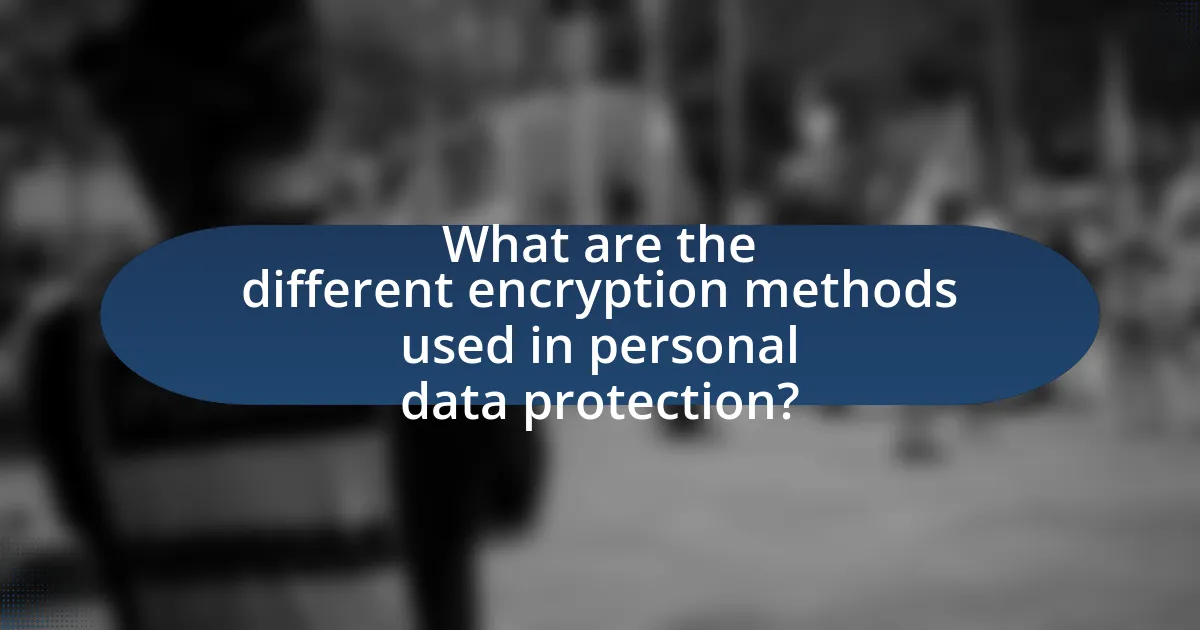
What are the different encryption methods used in personal data protection?
The different encryption methods used in personal data protection include symmetric encryption, asymmetric encryption, and hashing. Symmetric encryption, such as AES (Advanced Encryption Standard), uses the same key for both encryption and decryption, making it efficient for large data sets. Asymmetric encryption, exemplified by RSA (Rivest-Shamir-Adleman), employs a pair of keys—public and private—for secure data transmission, enhancing security for sensitive information. Hashing, utilized in data integrity verification, transforms data into a fixed-size string of characters, making it irreversible and ensuring that even a minor change in input results in a significantly different hash output. These methods are foundational in safeguarding personal data against unauthorized access and breaches.
How do symmetric and asymmetric encryption differ?
Symmetric and asymmetric encryption differ primarily in their key usage; symmetric encryption uses a single key for both encryption and decryption, while asymmetric encryption employs a pair of keys—one public and one private. In symmetric encryption, the same key must be shared and kept secret between the communicating parties, making it faster and more efficient for large data sets. In contrast, asymmetric encryption allows secure communication without the need to share a secret key, as the public key can be shared openly while the private key remains confidential. This fundamental difference impacts their applications, with symmetric encryption often used for bulk data encryption and asymmetric encryption utilized for secure key exchange and digital signatures.
What are the advantages and disadvantages of symmetric encryption?
Symmetric encryption offers the advantage of speed and efficiency in encrypting and decrypting data, as it uses a single key for both processes, making it faster than asymmetric encryption. This efficiency is particularly beneficial for large volumes of data, where symmetric algorithms like AES can process data quickly, achieving high performance in real-time applications. However, the primary disadvantage of symmetric encryption lies in key management; if the key is compromised, all data encrypted with that key is at risk, leading to potential security breaches. Additionally, distributing the key securely among users can be challenging, especially in large organizations, increasing the risk of unauthorized access.
What are the advantages and disadvantages of asymmetric encryption?
Asymmetric encryption offers significant advantages and disadvantages. The primary advantage is enhanced security; it uses a pair of keys (public and private) which allows secure communication without sharing the private key, reducing the risk of interception. This method is particularly useful for secure data transmission over the internet, as evidenced by its use in protocols like SSL/TLS.
Conversely, the main disadvantage is its computational inefficiency compared to symmetric encryption. Asymmetric encryption requires more processing power and time, making it slower for encrypting large amounts of data. This inefficiency can be a drawback in environments where speed is critical, such as real-time communications.
What role does encryption play in data transmission?
Encryption secures data transmission by converting information into a coded format that can only be read by authorized parties. This process protects sensitive data from unauthorized access during transfer over networks, ensuring confidentiality and integrity. For instance, the use of protocols like TLS (Transport Layer Security) encrypts data exchanged between web browsers and servers, significantly reducing the risk of interception by malicious actors. According to a report by the Ponemon Institute, 70% of organizations experienced data breaches due to unencrypted data transmission, highlighting the critical role encryption plays in safeguarding personal information.
How does encryption protect data during online transactions?
Encryption protects data during online transactions by converting sensitive information into a coded format that is unreadable to unauthorized users. This process ensures that even if data is intercepted during transmission, it remains secure and confidential. For instance, the use of protocols like HTTPS employs Transport Layer Security (TLS) to encrypt data exchanged between a user’s browser and a web server, making it difficult for attackers to access or manipulate the information. According to a study by the Ponemon Institute, 70% of organizations that implemented encryption reported a significant reduction in data breaches, highlighting the effectiveness of encryption in safeguarding personal data during online transactions.
What protocols utilize encryption for secure data transmission?
Protocols that utilize encryption for secure data transmission include HTTPS, SSL/TLS, SSH, and IPsec. HTTPS, which is HTTP over SSL/TLS, encrypts data between web browsers and servers, ensuring secure communication. SSL (Secure Sockets Layer) and its successor TLS (Transport Layer Security) provide encryption for various internet protocols, safeguarding data in transit. SSH (Secure Shell) encrypts data for secure remote access to servers, while IPsec (Internet Protocol Security) encrypts data at the IP layer, protecting data flows between network devices. These protocols are widely adopted to enhance data security and privacy during transmission.

What challenges are associated with encryption in personal data protection?
Encryption in personal data protection faces several challenges, including key management, performance issues, and regulatory compliance. Key management is critical because the security of encrypted data relies on the protection of encryption keys; if keys are lost or compromised, the data becomes inaccessible or vulnerable. Performance issues arise as encryption can slow down system operations, particularly in environments with large volumes of data, impacting user experience and system efficiency. Additionally, regulatory compliance presents challenges, as organizations must navigate various laws and regulations regarding data encryption, which can differ significantly across jurisdictions, complicating implementation and adherence.
What are the common misconceptions about encryption?
Common misconceptions about encryption include the belief that it guarantees complete security, that it is only necessary for sensitive data, and that it is too complex for average users. Encryption does not provide absolute security; vulnerabilities can exist in implementation or key management, as evidenced by high-profile breaches despite encryption being in place. Additionally, encryption is essential for all data types, not just sensitive information, as even seemingly innocuous data can be exploited. Lastly, advancements in user-friendly encryption tools have made it accessible, countering the notion that it is overly complex for non-experts.
How can misunderstanding encryption lead to data vulnerabilities?
Misunderstanding encryption can lead to data vulnerabilities by causing individuals or organizations to improperly implement or manage encryption protocols. For instance, if a user believes that simply encrypting data is sufficient for security without understanding the importance of key management, they may expose sensitive information if the encryption keys are poorly protected or shared. Research by the Ponemon Institute indicates that 60% of data breaches are due to human error, highlighting the critical role of understanding encryption practices. Additionally, misconfigurations in encryption settings can leave data unprotected, as seen in incidents where default settings were not changed, leading to unauthorized access. Thus, a lack of comprehension regarding encryption can directly result in significant security gaps.
What are the limitations of encryption in protecting personal data?
Encryption has limitations in protecting personal data, primarily due to vulnerabilities in key management, potential for data breaches, and reliance on user behavior. Key management issues arise when encryption keys are poorly stored or shared, making encrypted data accessible to unauthorized users. Additionally, if an attacker gains access to the system before encryption is applied, they can compromise the data regardless of its encrypted state. User behavior, such as weak passwords or falling for phishing attacks, can also undermine encryption efforts, as attackers may exploit these weaknesses to gain access to sensitive information. These factors highlight that while encryption is a critical tool for data protection, it is not infallible and must be part of a broader security strategy.
How can encryption be compromised despite its effectiveness?
Encryption can be compromised through various methods, including weak key management, implementation flaws, and social engineering attacks. Weak key management occurs when encryption keys are poorly generated, stored, or shared, making them susceptible to unauthorized access. For instance, the 2017 Equifax data breach highlighted how inadequate key management practices can lead to massive data exposure. Implementation flaws arise from vulnerabilities in the encryption algorithms or software, which can be exploited by attackers; the 2014 Heartbleed bug in OpenSSL is a notable example where a flaw allowed attackers to access sensitive data. Social engineering attacks manipulate individuals into revealing sensitive information, undermining encryption’s effectiveness; phishing attacks often target users to gain access to their encrypted data. These factors illustrate that while encryption is a powerful tool for data protection, it is not infallible and can be compromised through various vulnerabilities and human factors.
What best practices should individuals follow for effective encryption?
Individuals should follow several best practices for effective encryption, including using strong, unique passwords, enabling two-factor authentication, and regularly updating encryption software. Strong passwords should consist of at least 12 characters, combining letters, numbers, and symbols to enhance security. Two-factor authentication adds an additional layer of protection by requiring a second form of verification, significantly reducing the risk of unauthorized access. Regular updates to encryption software ensure that individuals benefit from the latest security patches and improvements, as vulnerabilities are often discovered and addressed by developers. Following these practices helps safeguard personal data against unauthorized access and breaches.
How can users choose the right encryption tools for personal data protection?
Users can choose the right encryption tools for personal data protection by evaluating their specific needs, assessing the tool’s security features, and considering user-friendliness. First, identifying the type of data that requires protection helps in selecting tools tailored for those specific needs, such as file encryption or secure messaging. Next, users should look for encryption tools that utilize strong algorithms, such as AES-256, and offer features like end-to-end encryption, which ensures that only the intended recipients can access the data. Additionally, user-friendliness is crucial; tools should have intuitive interfaces and provide adequate support or documentation. According to a study by the National Institute of Standards and Technology (NIST), using well-established encryption standards significantly reduces the risk of data breaches, reinforcing the importance of selecting reputable tools.
What steps can individuals take to enhance their encryption practices?
Individuals can enhance their encryption practices by using strong, unique passwords for each account and enabling two-factor authentication. Strong passwords typically consist of at least 12 characters, including a mix of letters, numbers, and symbols, which significantly reduces the risk of unauthorized access. Two-factor authentication adds an additional layer of security by requiring a second form of verification, such as a text message or authentication app, making it harder for attackers to gain access even if they have the password. Furthermore, individuals should regularly update their software and applications to protect against vulnerabilities, as outdated systems are often targeted by cybercriminals. Using reputable encryption tools, such as full-disk encryption for devices and end-to-end encryption for messaging apps, ensures that data remains secure during transmission and storage. According to a study by the Ponemon Institute, organizations that implement strong encryption practices can reduce the cost of data breaches by up to 50%, highlighting the effectiveness of these measures in protecting personal data.
